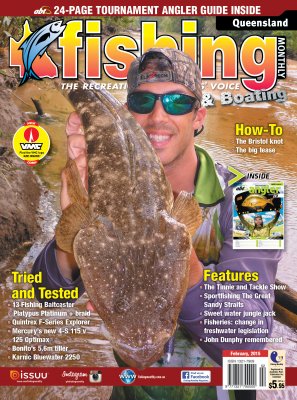Sportfishing The Great Sandy Straits by Mark Bargenquast
 During the past 10 years' guiding in Hervey Bay, I have had many people ask me what fishing is on offer in the Great Sandy Straits. Without a little bit of local knowledge, it can be very tough -- finding the fish, navigating the numerous channels and sandbars, and working out the tide heights can be hard going.
During the past 10 years' guiding in Hervey Bay, I have had many people ask me what fishing is on offer in the Great Sandy Straits. Without a little bit of local knowledge, it can be very tough -- finding the fish, navigating the numerous channels and sandbars, and working out the tide heights can be hard going.
The Straits start from Tin Can Bay in the south and run right up to Moon Point, however, ask any local and if they go fishing "down the Straits" it is generally a term for "south of River Heads" and this area from the mouth of the Mary River to the top of Tin Can Bay is what I am referring to in this article.
As usual in South East Queensland, we have 2 major seasons, summer and winter. Summer is realistically the best time to sportfish the area. The Mary River and the surrounding region has the second highest commercial catch rate of barramundi in the whole east coast of Australia, and going by catches I have seen in the past shows staggering numbers of barra and salmon are available this area (we are talking double figure tonnes per year). Recreationally, they can be tough, as the Mary system runs very dirty depending on tides and rainfall, making it almost impossible to get bit on lures unless you keep placing them right on their noses.
I remember talking to a pro barra netter working in the river and he told me of a 93 and a 97lb barra going through the co-op when he was working there years ago as a kid. These were wild salty barras, not hatchery-bred specimens either. My 12-year-old son recently caught and released a 132cm fish, and a mate of mine lost one of similar size, so they are there!
Most of the fish in the river are constantly moving, often holding on a spot/rockbar/eddy or snag for a short period before moving along with the tide, giving the angler a small window to get the bite. Things are a little easier further down the Straits where tidal movement is usually less harsh; find the fish in the holes and snags, keep working at them and eventually you will get a bite.
The bottom end of the Mary is a maze of rockbars, sandbanks and channels. During early summer, before rainfall dirties up the water, I have seen big golden trevally, queenfish, threadfin salmon and giant trevally on the sandbanks. The goldies are happily tailing on yabby banks, while the queenies and GTs are hunting garfish, mullet and whiting. These flats are also a great spot to try popper fishing for whiting on the last of the ebb tide. Big pikey bream and grunter are around the snags too, so they are worth a cast.